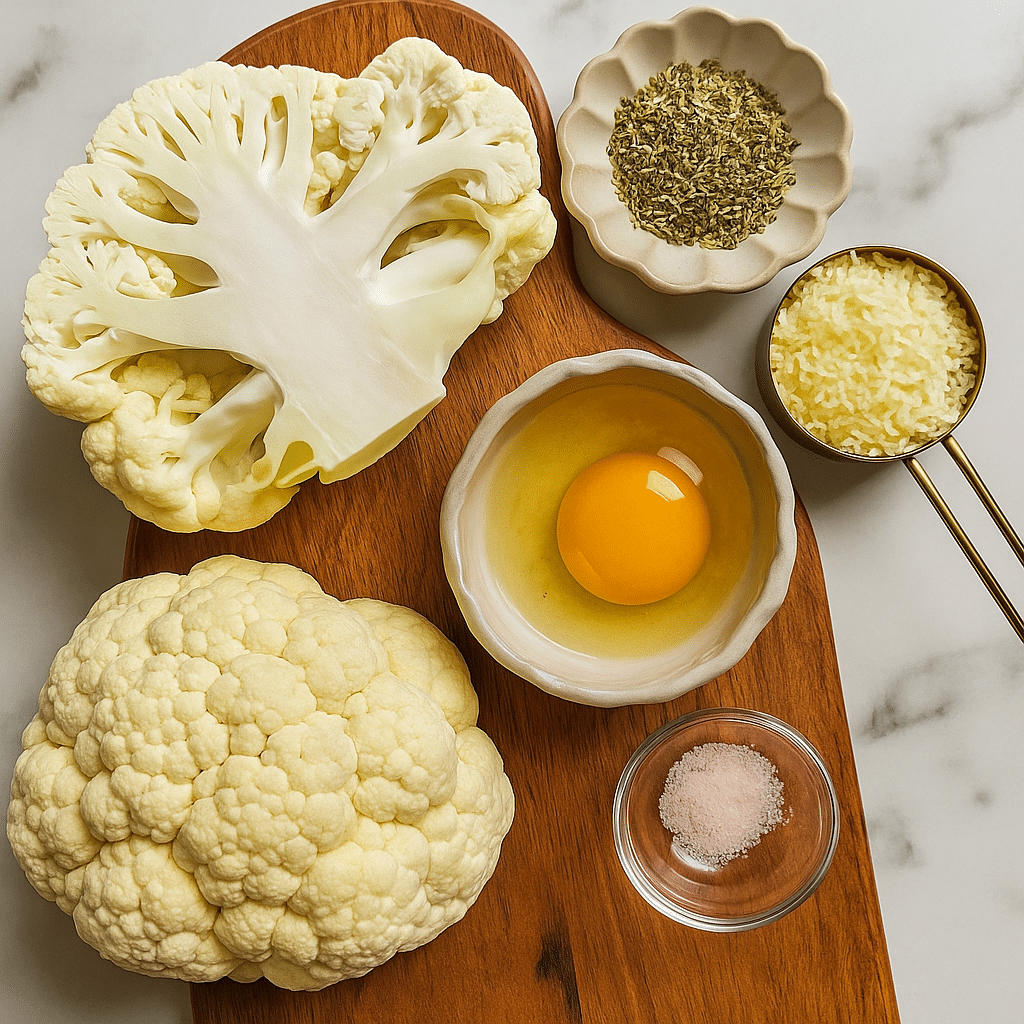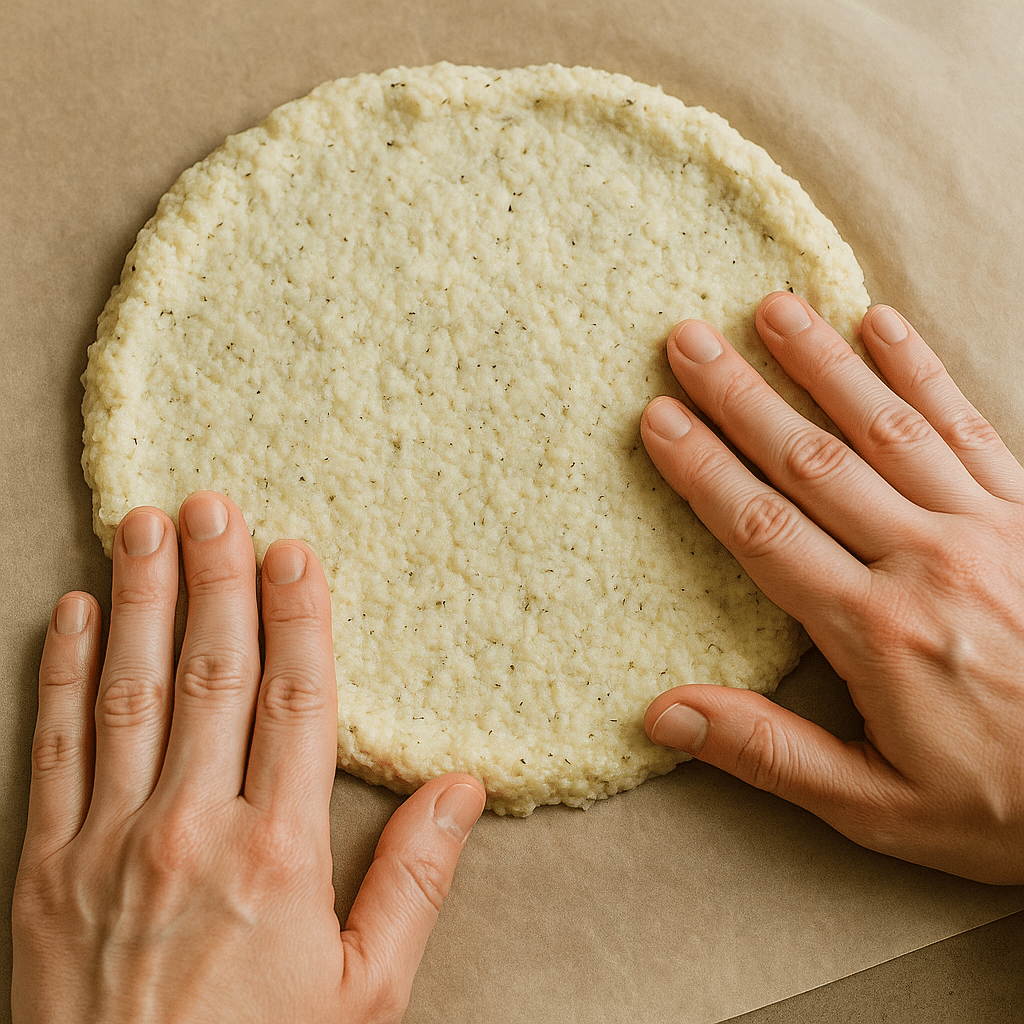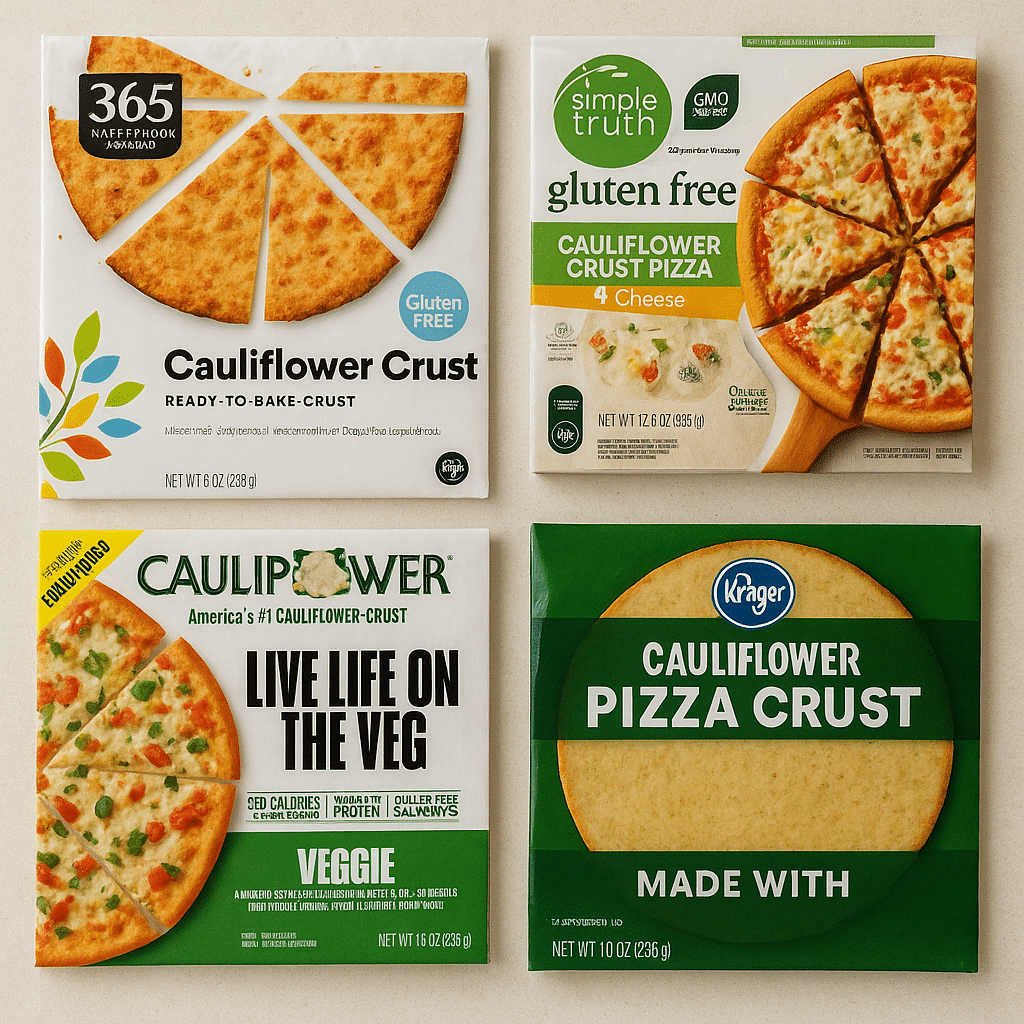If you’re trying to eat fewer carbs or avoid gluten but still crave pizza, cauliflower pizza crust might sound like a dream. Over the last few years, it’s taken grocery stores and Pinterest boards by storm. From homemade recipes to store-bought versions like Kroger cauliflower crust pizza and California Pizza Cauliflower Crust, this veggie-based alternative promises to be lighter, cleaner, and better for you—but is it really?

In this article, we’ll explore everything from what goes into a cauliflower crust to whether it’s truly low-carb and diabetic-friendly. We’ll also walk you through how to make your own crust at home, compare top store brands like Whole Foods cauliflower pizza crust, and weigh its pros and cons.
Don’t miss our complete cauliflower pizza crust guide for extra info on crust types and texture tips.
Table of Contents
The Rise of Cauliflower Pizza Crust
What Sparked the Trend of Cauliflower-Based Pizza?
Cauliflower crust didn’t just appear out of nowhere—it started showing up as a low-carb solution among keto dieters and gluten-sensitive foodies. Social media played a huge role, especially on platforms like Instagram and TikTok, where videos of golden-baked cauliflower crusts loaded with toppings went viral.
This trend was boosted by influencers and health-conscious bloggers touting it as a guilt-free way to enjoy pizza without the crash that often follows regular dough.
How Food Bloggers and Brands Popularized the Alternative Crust
Food blogs helped simplify the process with step-by-step tutorials on how to rice cauliflower, squeeze out moisture, and bind it with cheese and egg. But then came convenience—major brands jumped in. That’s when you started seeing options like:
| Brand | Product Name | Calories (per serving) | Net Carbs |
|---|---|---|---|
| Kroger | Kroger Cauliflower Crust Pizza | ~250 | 18g |
| Caulipower | California Pizza Cauliflower Crust | ~310 | 26g |
| 365 by Whole Foods | Whole Foods Cauliflower Pizza Crust | ~220 | 20g |
| Mighty Crust | Mighty Crust Cauliflower Pizza | ~270 | 19g |
Suddenly, cauliflower pizza became more than a DIY trend—it became a full-blown market category with freezer aisle real estate. Mighty Crust Cauliflower Pizza, in particular, positioned itself as both tasty and fiber-packed.
These companies capitalized on the health halo of vegetables, but not all store-bought versions live up to the “healthy” label, as we’ll explore in later parts of the article.
Print
Cauliflower Pizza Crust
- Prep Time: 20 minutes
- Cook Time: 45 minutes
- Total Time: 1 hour 5 minutes
- Yield: 4 servings
- Category: Main Dish
- Method: Baked
- Cuisine: American
Description
Make the best cauliflower pizza crust with this easy recipe! It’s low-carb and keto friendly, plus you’ll get extra veggies in each bite.
Ingredients
- 1 to 1.5 pounds cauliflower, riced
- 1 egg
- 1/3 cup shredded cheese (e.g. mozzarella or parmesan)
- 1/2 teaspoon dried oregano
- 1/4 teaspoon salt
Instructions
- Preheat the oven to 400ºF.
- Rice the cauliflower using a food processor.
- Spread cauliflower rice on a parchment-lined baking sheet and bake for 15 minutes until tender.
- Transfer cooked (or thawed) cauliflower to a clean dish towel and squeeze out excess moisture.
- In a bowl, mix cauliflower rice, egg, cheese, oregano, and salt.
- Press dough onto parchment-lined baking sheet about 1/4 inch thick.
- Bake at 400ºF for 30 minutes or until golden and dry.
- Add toppings and bake an additional 5-10 minutes.
- Slice and serve warm.
Notes
You can use fresh or thawed frozen cauliflower. Be sure to squeeze out as much moisture as possible for the best texture.
What Is Cauliflower Pizza Crust Made Of?
Main Ingredients in Homemade and Store-Bought Crusts
At its core, cauliflower pizza crust is a mix of finely riced cauliflower combined with a few simple binders—usually egg and cheese. The process starts by steaming the cauliflower, squeezing out as much moisture as possible (this step is crucial), and mixing it with binding agents like:
- Eggs
- Mozzarella or parmesan cheese
- Almond flour or coconut flour (optional)
- Herbs and seasoning (garlic powder, oregano, etc.)
For homemade versions, that’s typically all you need. But commercial brands often add more ingredients to increase shelf life, improve texture, or enhance taste.
Let’s look at a few common ingredients found in store-bought crusts:
| Ingredient | Purpose |
|---|---|
| Tapioca starch | Improves chewiness, raises carb count |
| Rice flour | Adds crispiness, also increases carbs |
| Cornstarch | Helps with binding, but not keto-friendly |
| Xanthan gum | Stabilizer to hold the crust together |
| Canola or sunflower oil | Boosts crispiness |
So while a homemade version may keep things clean and simple, buying from the store—like a Whole Foods cauliflower pizza crust—might mean you’re getting extra ingredients you didn’t bargain for.
Nutritional Breakdown of a Basic Cauliflower Crust
Here’s a side-by-side look at a typical homemade vs. store-bought cauliflower pizza crust for one serving (¼ of a 10” crust):
| Nutrition | Homemade | Store-Bought (Avg) |
|---|---|---|
| Calories | ~180 | 250–300 |
| Net Carbs | 6g–8g | 16g–28g |
| Protein | 9g | 6g–12g |
| Fat | 12g | 14g–20g |
| Fiber | 3g | 2g–5g |

While both options are generally lower in carbs than traditional crust, homemade crust offers more control and fewer processed ingredients. The key takeaway? Read labels carefully—brands like Kroger cauliflower crust pizza and California Pizza Cauliflower Crust often contain added starches that spike the carb count.
And don’t be fooled by the word “cauliflower” on the label—it might only be the third or fourth ingredient.
Discover great ideas like gluten-free cauliflower crust tweaks that reduce unnecessary binders.
Is Cauliflower Pizza Crust Actually Healthier?
Comparing Cauliflower Crust with Traditional Pizza Crust
When people switch to cauliflower pizza crust, the main hope is usually fewer calories and carbs. But is it actually healthier? Let’s break it down:
| Nutrient | Traditional Crust (1 slice) | Cauliflower Crust (1 slice) |
|---|---|---|
| Calories | 250–300 | 180–250 |
| Net Carbs | 30–35g | 6–26g (depending on brand) |
| Protein | 6–8g | 6–10g |
| Fiber | 1–2g | 2–5g |
| Gluten | Yes | Often gluten-free |
So yes, in many cases, cauliflower crust is lower in calories and carbs—especially if you’re making it at home. It’s also naturally gluten-free, which is a win for people with celiac or gluten sensitivities.
But watch out: many store-bought versions use starchy binders like rice flour, cornstarch, or tapioca starch to hold the crust together. That’s why some products, like California Pizza Cauliflower Crust, can end up with nearly as many carbs as a regular crust.
Benefits: Calories, Carbs, Gluten-Free Potential
Let’s look at where cauliflower crust shines:
- Lower in calories: Especially helpful for those watching weight.
- Lower net carbs: Great for keto or low-carb diets.
- Vegetable-based: Adds fiber and micronutrients.
- Gluten-free: A solid substitute for people avoiding wheat.
On the flip side, not all cauliflower crusts are created equal. Some have only a tiny amount of cauliflower and plenty of starchy fillers. This is especially true for some store-bought versions that prioritize texture over nutrition.
If you’re watching your macros, the mighty crust cauliflower pizza brand, for example, includes both tapioca starch and brown rice flour—both of which raise the carb count. So while it’s marketed as healthy, it might not fit into strict low-carb plans.
Pro Tip: Look at the ingredient list. If cauliflower isn’t the first or second ingredient, chances are it’s not the star of the show.
Carbs in Cauliflower Pizza Crust: Myth vs. Reality
How Many Carbs Are in Cauliflower Crust Really?
Cauliflower has long been a go-to for low-carb eaters, but not all cauliflower crusts are created equal. While cauliflower itself is low in carbohydrates (about 5g per cup), the finished crust may have up to 30g of net carbs per slice, depending on the recipe or brand.
Here’s a breakdown of net carbs in popular cauliflower pizza crusts per slice (¼ of 10” pizza):
| Brand | Net Carbs | Primary Ingredients |
|---|---|---|
| Homemade | 6–8g | Cauliflower, egg, cheese |
| Kroger Cauliflower Crust Pizza | 18g | Cauliflower, rice flour, starches |
| California Pizza Cauliflower Crust | 26g | Cauliflower, mozzarella, tapioca starch |
| Whole Foods Cauliflower Pizza Crust | 20g | Cauliflower, brown rice flour, oil |
| Mighty Crust Cauliflower Pizza | 19g | Cauliflower, egg, cheese, starch blend |
What’s the takeaway here? Store-bought options often contain rice flour, potato starch, or tapioca starch—these are used for structure and crunch, but they also drive up the carb content.
If you’re eating low-carb for keto, diabetes, or weight loss, homemade crusts are almost always the better choice. Otherwise, you might as well be eating a thin wheat crust.
Why Some Cauliflower Pizzas Are Still High in Carbs
The problem lies in how manufacturers label and market the product. Many pizzas labeled “cauliflower crust” contain only a small percentage of actual cauliflower. The rest? Starches, stabilizers, and oils.
Some brands even add cane sugar or honey for flavor enhancement, making them unsuitable for low-carb diets.
Let’s decode the marketing:
| Label Claim | What It Often Means |
|---|---|
| “Made with cauliflower” | Might contain <30% cauliflower |
| “Gluten-free” | Doesn’t mean low-carb |
| “Low-carb” | Only true if net carbs <10g per serving |
So when scanning the freezer aisle, don’t be fooled by the healthy-looking green packaging or buzzwords. Read the nutrition label and ingredient list carefully.
Brands like Whole Foods cauliflower pizza crust and Kroger cauliflower crust pizza are better than traditional crusts—but still far from keto-perfect.
Smart Shopper Tip: Choose crusts where cauliflower is the first ingredient, and total net carbs are under 10g per slice.
How Cauliflower Crust Affects Blood Sugar
Is Cauliflower Pizza Crust Diabetic-Friendly?
At first glance, cauliflower pizza crust seems perfect for diabetics. After all, it’s made from a non-starchy vegetable that’s naturally low on the glycemic index (GI). For those looking to manage glucose levels without giving up pizza altogether, it can be a game-changer.
Homemade cauliflower pizza crust—crafted with just riced cauliflower, cheese, and egg—has a very low glycemic load. This makes it ideal for people with diabetes or prediabetes. You’ll likely see only a mild, gradual increase in glucose levels, if any at all.
However, commercial versions like California Pizza Cauliflower Crust or Kroger Cauliflower Crust Pizza often tell a different story. These crusts typically contain added starches such as rice flour, potato starch, and tapioca, which can significantly raise blood sugar levels.
Here’s how blood sugar response may vary:
| Type | GI Impact | Notes |
|---|---|---|
| Homemade Cauliflower Pizza Crust | Low | Minimal rise in blood glucose |
| Store-Bought (Low Carb) | Medium | Mild to moderate impact |
| Store-Bought (High Starch) | High | Can spike blood sugar quickly |
If you’re diabetic, it’s essential to evaluate both the net carbs and the type of starches used in the crust. Just because a product is gluten-free doesn’t mean it won’t affect your glucose. Even seemingly healthy options like Mighty Crust Cauliflower Pizza may raise blood sugar if the formulation includes high-GI binders.
Glycemic Index and Impact on Blood Sugar Levels
The glycemic index (GI) measures how quickly a food raises your blood sugar. While plain cauliflower has a GI of 15 (extremely low), added starches in some cauliflower pizza crust recipes can send that number skyrocketing.
Let’s compare some common ingredients used in store-bought crusts:
| Ingredient | Glycemic Index (GI) |
|---|---|
| Cauliflower | 15 |
| Rice Flour | 72 |
| Tapioca Starch | 85 |
| Potato Starch | 90 |
As shown above, many store-bought cauliflower pizza crusts use high-GI ingredients to improve texture and structure. While these make the crust crispier, they also compromise its benefits for blood sugar control.
Smart Tip: To enjoy the full health benefits of cauliflower pizza crust—especially for blood sugar management—opt for homemade versions or low-carb certified brands. Also, pay attention to toppings. Even the healthiest crust can become carb-heavy when loaded with sugary sauces or cured meats.y be low-carb, loading it with sugary sauces or processed meats can quickly offset the benefits.
How to Make Your Own Low-Carb Cauliflower Pizza Crust
Step-by-Step Homemade Cauliflower Pizza Crust Recipe
Making your own cauliflower pizza crust at home not only saves money—it gives you full control over ingredients, carb count, and taste. This DIY version is naturally gluten-free, low in carbs, and has a crisp edge and soft, chewy center.
Here’s a foolproof recipe:
Ingredients (makes 1 medium crust):
- 1 medium head of cauliflower (about 3 cups, riced)
- 1 large egg
- ½ cup shredded mozzarella cheese
- ¼ cup grated parmesan cheese
- ½ teaspoon garlic powder
- ½ teaspoon dried oregano
- Pinch of salt
Instructions:
- Preheat your oven to 425°F (220°C) and line a baking sheet with parchment paper.
- Rice the cauliflower: Use a food processor or box grater to finely grate the cauliflower into a rice-like texture.
- Cook and dry: Steam or microwave the cauliflower for 5–6 minutes. Let cool, then wrap it in a clean kitchen towel or cheesecloth and squeeze out as much moisture as possible. This step is crucial for a crispy crust.
- Mix the dough: In a large bowl, combine the dried cauliflower rice with the egg, cheeses, and seasonings. Stir until fully mixed.
- Shape the crust: Place the mixture on the parchment-lined baking sheet and flatten into a 10-inch round crust, about ¼ inch thick.
- Bake: Place in the oven for 20–25 minutes, or until the crust is golden brown and firm.
- Add toppings and bake again: Top with your favorite low-sugar sauce, veggies, and more cheese. Return to the oven for another 10 minutes or until toppings are melted and bubbly.
Pro Tip: For an even crispier base, flip the crust after the first bake and return it to the oven for 5 more minutes before adding toppings.

Tips to Keep It Crispy and Carb-Light
Even though cauliflower has a high water content, you can still achieve a crispy, sturdy crust by following a few key tips:
- Dry thoroughly: Use a towel or nut milk bag to remove every drop of moisture.
- Add cheese for binding: Mozzarella and parmesan act as a natural glue and boost flavor.
- Avoid flour or starches: Stick to whole ingredients to keep the carb count low.
This simple crust contains just 6–8g net carbs per slice, making it ideal for keto and diabetic diets. Plus, it tastes so much better than many store-bought versions like Kroger Cauliflower Crust Pizza or Whole Foods Cauliflower Pizza Crust—without the added starches or preservatives.
You can even get creative by mixing in herbs like basil or adding a bit of crushed red pepper for extra kick.
Discover great ideas like gluten-free cauliflower crust tweaks that reduce unnecessary binders.
Store-Bought Cauliflower Pizza Crust Brands Compared
Best Cauliflower Pizza Crusts on the Market
Not everyone has the time (or desire) to make cauliflower pizza crust from scratch. Luckily, the market offers plenty of ready-to-bake options. But are they all created equal? Definitely not.
Below, we compare some of the top-selling cauliflower pizza crust brands available at major retailers like Kroger, Whole Foods, and national frozen food chains. We’ll rank them based on carb content, ingredients, and overall health factor.
1. Kroger Cauliflower Crust Pizza
- Net Carbs: 18g per slice
- Ingredients: Cauliflower, rice flour, mozzarella cheese, corn starch, potato starch
- Gluten-Free: Yes
- Review: Offers convenience and decent taste, but the inclusion of rice and corn starch raises the carb load significantly. Better than traditional crust, but not ideal for strict low-carb diets.
2. California Pizza Kitchen’s Cauliflower Crust
- Net Carbs: 26g per slice
- Ingredients: Cauliflower, mozzarella cheese, tapioca starch, rice flour
- Gluten-Free: Yes
- Review: Widely available and tasty, but surprisingly high in carbs. Despite the cauliflower label, this crust behaves more like traditional dough due to starch content.
3. Whole Foods Cauliflower Pizza Crust (365 Everyday Value)
- Net Carbs: 20g per slice
- Ingredients: Cauliflower, brown rice flour, potato starch, sunflower oil
- Gluten-Free: Yes
- Review: A decent middle ground. Contains more cauliflower than some competitors but still relies on carb-heavy flours. Not ideal for keto, but manageable for moderate low-carb eaters.
4. Mighty Crust Cauliflower Pizza
- Net Carbs: 19g per slice
- Ingredients: Cauliflower, parmesan cheese, tapioca starch, flaxseed
- Gluten-Free: Yes
- Review: A flavorful, fiber-friendly option thanks to the flaxseed. While carbs are not ultra-low, it has a balanced profile and clean ingredients. One of the better frozen options if you’re not on a strict keto plan.

Ingredient Lists and Carb Counts Compared
Here’s a quick comparison table:
| Brand | Net Carbs | Notable Ingredients | Keto-Friendly? |
|---|---|---|---|
| Homemade | 6–8g | Cauliflower, cheese, egg | ✅ Yes |
| Kroger | 18g | Rice flour, corn starch | ❌ No |
| California Pizza | 26g | Tapioca starch, rice flour | ❌ No |
| Whole Foods | 20g | Brown rice flour, oil | ⚠️ Limited |
| Mighty Crust | 19g | Flaxseed, tapioca starch | ⚠️ Moderate |
Buyer Tip: Don’t judge by brand name alone. Look at the ingredient list and the order—the closer cauliflower is to the top, the better. Also, choose options with minimal starches and no added sugars.
For those on a low-carb or gluten-free diet, even the best store-bought cauliflower crusts might not be perfect—but they can work in a pinch. If health is your top priority, homemade cauliflower pizza crust is still the gold standard.
Alternatives to Cauliflower – Healthiest Pizza Crusts
Almond Flour, Chickpea, Zucchini, and Other Options
While cauliflower pizza crust is a standout choice for those cutting carbs or avoiding gluten, it’s not the only healthy option. In fact, some people prefer other vegetable-based or grain-free crusts due to flavor preferences, allergies, or even macros.
Here are some great alternatives that are both nutritious and low-carb:
1. Almond Flour Pizza Crust
- Benefits: Rich in healthy fats, vitamin E, and naturally low in carbs
- Drawbacks: High in calories, contains nuts (allergen)
- Best For: Keto, paleo, and gluten-free diets
- Texture: Slightly crumbly but rich and flavorful
2. Chickpea (Garbanzo) Crust
- Benefits: High in fiber and protein, good iron source
- Drawbacks: Moderate in carbs, not grain-free
- Best For: Plant-based and vegetarian diets
- Texture: Slightly chewy, nutty flavor
3. Zucchini Crust
- Benefits: Very low in calories and carbs, packed with vitamin C
- Drawbacks: High moisture content—needs draining
- Best For: Low-calorie, low-carb diets
- Texture: Soft and light, great for thin-crust fans
4. Eggplant or Sweet Potato Bases
- Benefits: Nutrient-rich, easy to slice and bake
- Drawbacks: Higher in carbs (especially sweet potato)
- Best For: Whole food-based diets
- Texture: Thicker, heartier feel
Which Healthy Crust Fits Your Lifestyle Best?
Choosing a crust really depends on your dietary needs:
| Diet Type | Best Crust Option |
|---|---|
| Keto / Low-Carb | Almond Flour, Homemade Cauliflower Crust |
| Gluten-Free | Cauliflower, Chickpea, Almond Flour |
| Vegan | Chickpea, Zucchini, Sweet Potato |
| Low-Calorie | Zucchini, Cauliflower |
| Whole Food / Clean Eating | Eggplant, Homemade Veggie-Based |
Note: While cauliflower pizza crust remains one of the most versatile options, trying other low-carb crusts can add variety and help you avoid ingredient fatigue.
You can even get creative by combining ingredients—like almond flour with zucchini—to create a custom blend that suits your taste and texture preference.
And for those seeking convenience, some brands now offer pre-made almond flour and chickpea crusts that are free of added sugars and starches. Just like with cauliflower options, always read the label!
Learn more about cauliflower almond pizza crust if you want a nuttier, more fiber-rich crust option.
Conclusion: Is Cauliflower Pizza Crust Right for You?
Cauliflower pizza crust has earned its place in modern kitchens for good reason. It’s lighter than traditional dough, easy to customize, and perfect for those watching carbs or avoiding gluten. But not all cauliflower crusts are created equal.
Here’s the final word:
- Make it at home if you want true low-carb, clean ingredients.
- Read labels carefully on store-bought brands—many sneak in starches.
- Choose options where cauliflower is the first ingredient, and net carbs are under 10g per slice.
Whether you’re following a keto plan, managing blood sugar, or just trying to eat smarter, this crust is a delicious and smart way to enjoy pizza without guilt.
Cook smarter, not harder — follow Mr.Chef Recipes on Pinterest and save your favorite clean eats.
FAQs About Cauliflower Pizza Crust
Does a cauliflower pizza crust have carbs?
Absolutely. While cauliflower itself is low in carbs, the final crust—especially store-bought—often includes starches like tapioca, rice flour, or potato starch. A homemade cauliflower pizza crust might have just 6–8g net carbs per slice, whereas some commercial versions go as high as 26g.
What goes into a cauliflower pizza crust?
A basic cauliflower pizza crust typically includes riced cauliflower, egg, mozzarella or parmesan cheese, and herbs. Commercial brands may also add binding agents like tapioca starch, rice flour, or cornstarch to improve texture—but these raise the carb count.
Why is Caulipower pizza so high in carbs?
While Caulipower pizza uses cauliflower as a base ingredient, it also contains high-carb binders like tapioca starch and rice flour. This is why a single slice can have as many carbs as regular thin-crust pizza. It’s marketed as healthier but may not be suitable for strict low-carb diets.
Will cauliflower pizza spike your blood sugar?
That depends. Homemade cauliflower crust typically has a low glycemic impact. But store-bought versions—like Kroger cauliflower crust pizza or California Pizza Cauliflower Crust—may spike blood sugar due to refined starches. Diabetics should monitor glucose response and stick to low-carb versions.
What is the healthiest pizza crust?
The healthiest pizza crust is one made with whole, nutrient-dense ingredients. Homemade cauliflower pizza crust, almond flour crust, or zucchini-based crusts are excellent options. They’re low in carbs, gluten-free, and packed with fiber—making them ideal for a variety of dietary needs.
